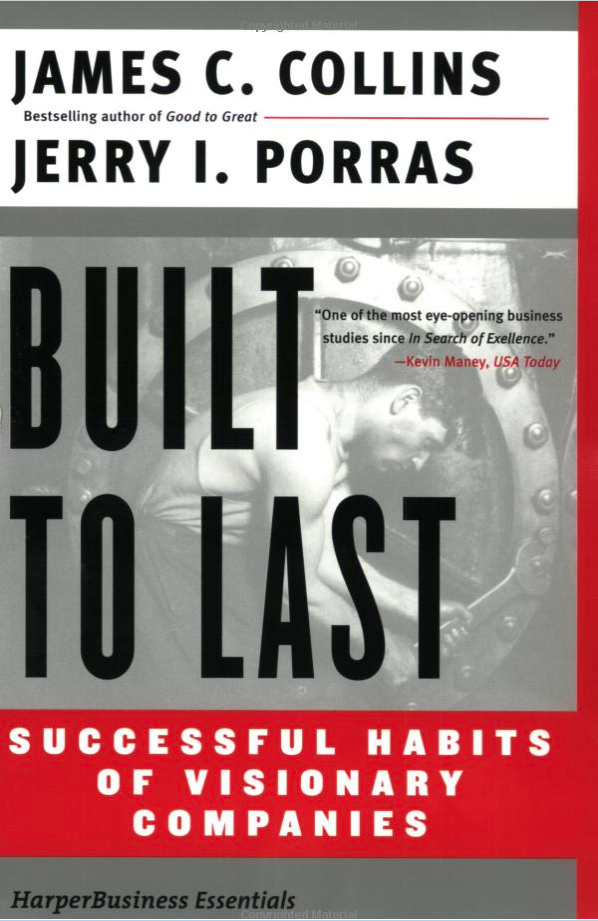-
“Built to Last” James C. Collins and Jerry I Porras
Summary:
The authors’ key premise is that:
“Preserve the Core / Stimulate Progress” Visionary companies have a set of core principles that are absolutely central and unchangeable, and are clear on these principles. They’re committed to moving forwad and changing their practices outside of the principles. Preserve core values and purposes; Change culture and operating practices and specific goals and strategies.
There are a set of key habits or attributes that differentiate visionary companies from similar companies in their industry
BHAGs – Big, Hairy, Audacious Goals – A true BHAG is clear and compelling and serves as a unifying point of local effort, often creating immense team spirit. It engages people, reaches out and grabs them right in the gut. People “get it” right away – it takes little or no explanation. Key thing here is the goal, not the specific leader. It’s a goal, not a statement – if it doesn’t get people’s juices going then it’s not a BHAG. It should fall well outside of the comfort zone.
“Tyranny of the OR”, Genius of the AND” – Visionary companies don’t get locked into a choice or a balance between two extremes in a dimension. They’re able to embrace both sides at the same time (e.g., demands for short term performance and long term growth; conservative around the core, ability to change, move, adapt). Balance implies sacrificing one for another, trading off, 50/50.
“In our view corporations resemble nations in that they reflect the accumulation of past events and the shaping force of underlying genetics that have their roots in prior generations.”
“Builders of visionary companies tend to be clock builders, not time tellers. They concentrate primarily on building an organization rather than hitting a market just right with a revolutionary product or idea and…” riding out the life cycle.
The essence of clock building is the critical importance of creating tangible mechanisms aligned to preserve the core and stimulate progress.
“…shift from seeing the company as a vehicle for the products to seeing the products as a vehicle for the company.”… crucial shift in thinking – the shift to seeing the company as the ultimate creation. It means spending less of my time thinking about specific product lines and marketing strategies, and more of my time thinking about organization design”
“Profitability is a necessary condition for existence and a means to a more important ends, but it is not the end itself for many visionary companies. Profit is like oxygen, food, water and blood for the body; they are not the point of life, but without them there is no life.”
There is no “right” ideology. “Our research indicates that the authenticity of the ideology and the extent to which a company attains consistent alignment with the ideology counts more than the content of the ideology.”
“Visionary… does not mean soft and undisciplined. Quite the contrary. Because the visionary companies have such clarity about who they are, what they’re all about, and what they’re trying to achieve, then tend not to have much room for people unwilling or unsuited to their demanding standards.”
“Comfort is not the objective at visionary companies. Indeed, visionary companies install powerful mechanisms to create discomfort – to obliterate complacency – and thereby stimulate change and improvement before the external world demands it.”
Managers at visionary companies simply do not accept the proposition that they must choose between short-term performance or long-term success. The build first and foremost for the long term while simultaneously holding themselves to highly demanding short-term standards”
Specific Methods of Preserving the Core and Stimulating Progress:
BHAGs
Cult-like cultures (great places to work only for those who fit in)
Try a lot of stuff and keep what works
Home grown management
Good enough never is
Ideology:
Visonary companies more fully indoctrinate employees into a core ideology, creating almost cult-like cultures.
Visionary companies more carefully nurture and select senior management based on fit with a core ideology.
Visionary companies attain more consistent alignment with a core ideology – in such respects as goals, strategy, tactics, organization design.
Lessons of Alignment:
Paint the Whole Picture. Visionary companies do not rely on any one program, strategy, tactic, mechanism, cultural norm, symbolic gesture or CEO speech to preserve the core and stimulate progress. It’s the whole ball of wax that counts.
Sweat the Small Stuff: People don’t work day-to-day in the big picture. Not that the big picture is irrelevant, but it’s the little things that make a big impression and send powerful signals.
Cluster, Don’t Shotgun: Don’t put in place random mechanisms, having all the pieces reinforce each other.
Swim in Your Own Current, Even if You Swim Against the Tide:
Obliterate Misalignments: In goals, strategies, processes, systems for appraisal and compensation, etc.
Keep the Universal Requirements While Inventing New Methods

